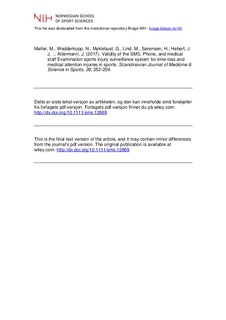| dc.contributor.author | Møller, Merete | |
| dc.contributor.author | Wedderkopp, Niels | |
| dc.contributor.author | Myklebust, Grethe | |
| dc.contributor.author | Lind, Martin | |
| dc.contributor.author | Sørensen, Henrik | |
| dc.contributor.author | Hebert, Jeffrey J. | |
| dc.contributor.author | Emery, Carolyn A. | |
| dc.contributor.author | Attermann, Jørn | |
| dc.date.accessioned | 2018-05-18T12:49:01Z | |
| dc.date.available | 2018-05-18T12:49:01Z | |
| dc.date.created | 2018-01-11T13:51:12Z | |
| dc.date.issued | 2017 | |
| dc.identifier.citation | Scandinavian Journal of Medicine & Science in Sports. 2017, 28, 1424–1434. | nb_NO |
| dc.identifier.issn | 0905-7188 | |
| dc.identifier.uri | http://hdl.handle.net/11250/2498589 | |
| dc.description | I Brage finner du siste tekst-versjon av artikkelen, og den kan inneholde ubetydelige forskjeller fra forlagets pdf-versjon. Forlagets pdf-versjon finner du på wiley.com / In Brage you'll find the final text version of the article, and it may contain insignificant differences from the journal's pdf version. The definitive version is available at wiley.com | nb_NO |
| dc.description.abstract | The accurate measurement of sport exposure time and injury occurrence is key to effective injury prevention and management. Current measures are limited by their inability to identify all types of sport-related injury, narrow scope of injury information, or lack the perspective of the injured athlete. The aims of the study were to evaluate the proportion of injuries and the agreement between sport exposures reported by the SMS messaging and follow-up telephone part of the SMS, Phone, and medical staff Examination (SPEx) sports injury surveillance system when compared to measures obtained by trained on-field observers and medical staff (comparison method). We followed 24 elite adolescent handball players over 12 consecutive weeks. Eighty-six injury registrations were obtained by the SPEx and comparison methods. Of them, 35 injury registrations (41%) were captured by SPEx only, 10 injury registrations (12%) by the comparison method only, and 41 injury registrations (48%) by both methods. Weekly exposure time differences (95% limits of agreement) between SPEx and the comparison method ranged from −4.2 to 6.3 hours (training) and −1.5 to 1.0 hours (match) with systematic differences being 1.1 hours (95% CI 0.7 to 1.4) and −0.2 (95% CI −0.3 to −0.2), respectively. These results support the ability of the SPEx system to measure training and match exposures and injury occurrence among young athletes. High weekly response proportions (mean 83%) indicate that SMS messaging can be used for player measures of injury consequences beyond time-loss from sport. However, this needs to be further evaluated in large-scale studies. | nb_NO |
| dc.language.iso | eng | nb_NO |
| dc.subject | athletic injury | nb_NO |
| dc.subject | handball | nb_NO |
| dc.subject | injury registration | nb_NO |
| dc.subject | surveillance | nb_NO |
| dc.subject | validation study | nb_NO |
| dc.title | Validity of the SMS, Phone, and medical staff Examination sports injury surveillance system for time-loss and medical attention injuries in sports | nb_NO |
| dc.title.alternative | Validity of the SMS, Phone, and medical staff Examination sports injury surveillance system for time-loss and medical attention injuries in sports | nb_NO |
| dc.type | Journal article | nb_NO |
| dc.type | Peer reviewed | nb_NO |
| dc.description.version | acceptedVersion | nb_NO |
| dc.source.journal | Scandinavian Journal of Medicine & Science in Sports | nb_NO |
| dc.identifier.doi | 10.1111/sms.12869 | |
| dc.identifier.cristin | 1540839 | |
| dc.description.localcode | Seksjon for idrettsmedisinske fag / Department of Sport Medicine | nb_NO |
| cristin.unitcode | 150,34,0,0 | |
| cristin.unitname | Seksjon for idrettsmedisinske fag | |
| cristin.ispublished | true | |
| cristin.fulltext | postprint | |
| cristin.qualitycode | 2 | |
